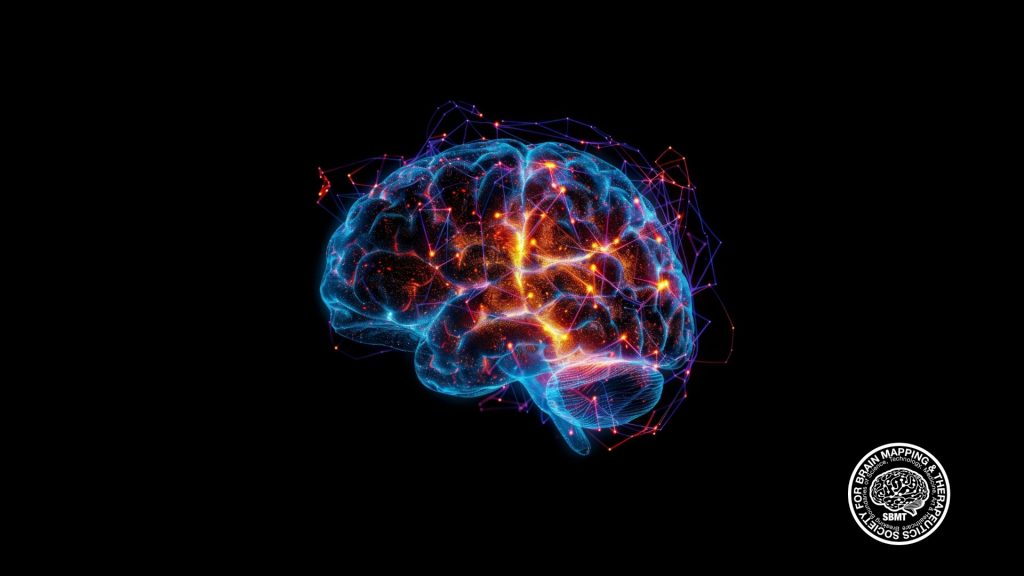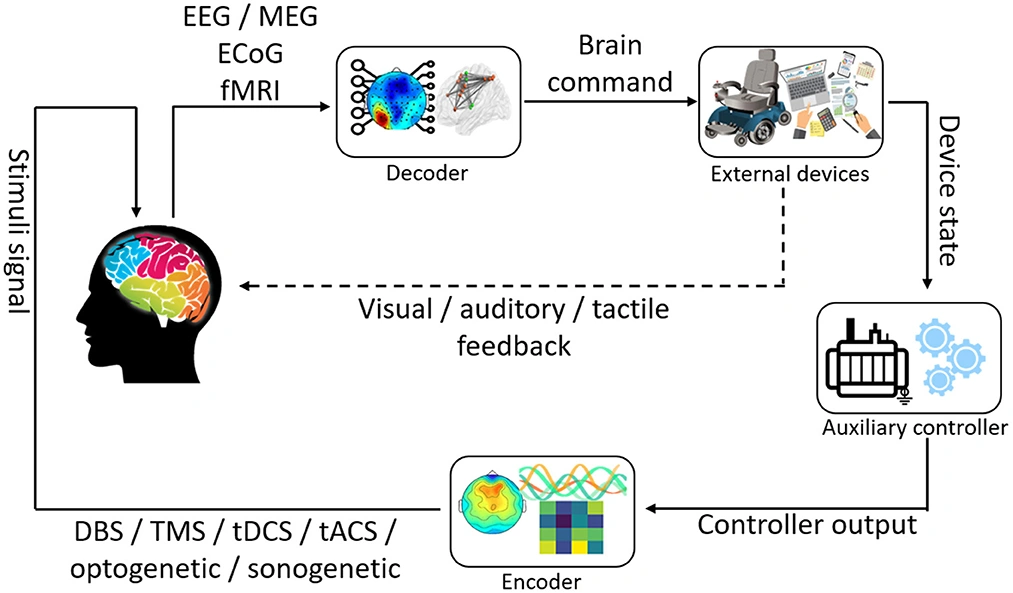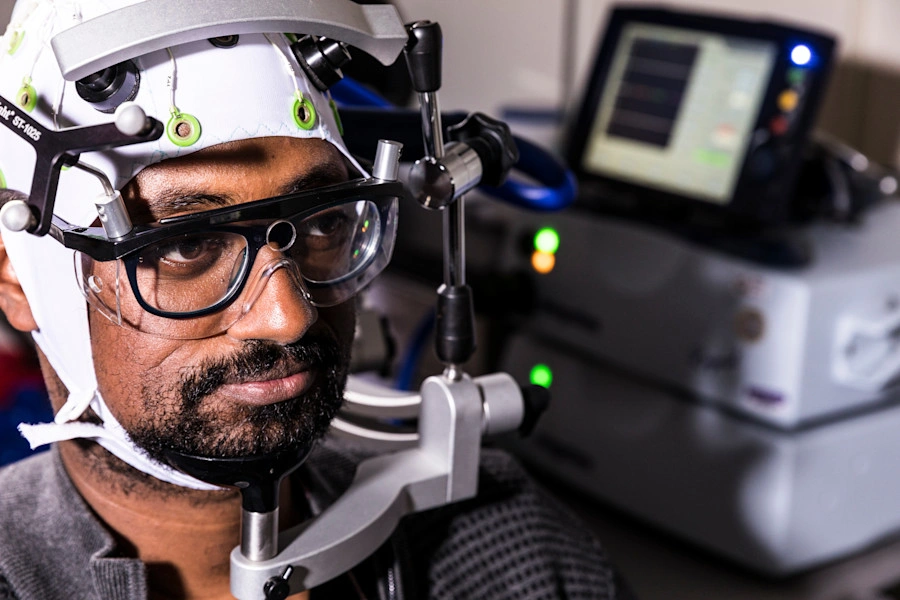
What Is Neurotechnology?
A Brain-Tech Guide
What is Neurotechnology?
Neurotechnology represents any method or electronic device that connects with the nervous system to monitor or change neural activity [1]. The assembly of methods and instruments enables direct connection of technical components with the nervous system [2]. These components include electrodes, computers, and intelligent prostheses that record brain signals and translate them into technical control commands, or manipulate brain activity through electrical or optical stimuli [2].
Neurotechnology creates pathways for communication between neural systems and external devices. This field merges advances in neuroscience, engineering, and computing to develop solutions that improve brain function and enhance human capabilities [3]. The neurotechnology market grows faster, expected to reach USD 1.72 billion by 2022 [4].
Neurotechnology divides into three main categories:
Neuromodulation technologies – These use neural interfaces to stimulate nervous system structures to influence neural activity. Deep brain stimulation reduces tremor in Parkinson’s disease while spinal cord stimulation treats chronic pain [5].
Neuroprostheses – These work as “prosthetic” brain functions that replace or restore sensory, motor, or cognitive functions. Cochlear implants restore hearing in people with profound hearing loss and stand as the most successful example with approximately 736,900 implants worldwide as of December 2010 [6].
Brain-machine interfaces (BMIs) – These technologies read and write information into the brain, letting subjects control external software or hardware devices. BMIs record brain activity, transmit information, process data through algorithms, and convert them into command control signals [4].
Scientists classify neurotechnological approaches as invasive or non-invasive. Non-invasive methods use electrode caps on the head’s surface to detect electrical fields from the active brain [2]. Invasive methods place recording electrodes inside the brain, closer to nerve cells, which provides more precise and specific readouts [2].
The Global Brain Mapping Organization (SBMT) leads neurotechnology advancement worldwide. It promotes public welfare and improves patient care by turning new technologies into lifesaving diagnostic and therapeutic procedures.
Neurotechnology’s history spans nearly half a century, but it reached maturity over the last several years [1]. Brain imaging revolutionized the field and allows researchers to monitor brain activities during experiments directly [1]. The technology’s scope extends beyond physical limitations and offers solutions for mood-related conditions [7].
This powerful research tool advances fundamental neuroscience knowledge beyond its therapeutic uses [1]. Current applications treat epilepsy, Parkinson’s disease, chronic pain, hearing loss, and paralysis [4]. The technology improves stroke patients’ motor coordination, reduces epileptic episodes, and helps reduce phantom pain perception [1].
Neurotechnology works like a tuning fork despite its technical complexity. It nudges each brain section back on pitch and steps aside so normal function can resume [7].
Why is Neurotechnology Important?
Neurotechnology’s global reach comes from its ability to help people with widespread neurological and psychiatric conditions. One in eight people worldwide now live with a mental or neurological disorder [6]. This number shows just how many people could benefit from advances in this field. Neurological disorders like Parkinson’s disease, stroke, and spinal cord injury pose substantial threats to human mortality, morbidity, and functional independence [4]. The development of technologies that work with the nervous system has become a vital frontier in state-of-the-art medicine.
Medical treatments have improved substantially thanks to neurotechnology, especially when dealing with neurological disorders [6]. Scientists have found remarkable ways to diagnose, treat, and rehabilitate neurological conditions [4]. These technologies give us a great way to get insights into brain functions and pathologies that go beyond traditional methods. Patients can now control prosthetic devices or computer systems through thought, which helps bypass damaged neural pathways [4].
The economic effects of neurotechnology are substantial. Investments in neurotech companies grew by 700% from 2014 to 2021, reaching USD 33.2 billion [6]. This quick growth shows both its promising uses and strong market demand. The USA houses 50% of 1,400 neurotech companies, while Europe and the UK have 35% [6], suggesting how state-of-the-art solutions spread globally in this field.
Neurotechnology serves several vital functions beyond treating disease:
Understanding brain function – We learn about the neural foundations of cognition, emotion, and behavior, which helps develop new treatments for neurological and psychiatric conditions [4]
Restoring capabilities – People with paralysis, ALS, or muscular disorders can regain their ability to communicate or control prosthetic limbs [4]
Enhancing human-computer interaction – Brain-computer interfaces enable hands-free control of devices, useful in both medical and non-medical fields [4]
Clinical success stories prove neurotechnology’s worth. Deep Brain Stimulation received FDA approval in 1997 to treat essential tremor. The FDA approved it for Parkinson’s disease in 2002, dystonia in 2003, and obsessive-compulsive disorder in 2009 [7]. A wireless EEG headset became the first wearable brain-computer interface for rehabilitation to get FDA market authorization in April 2021. This device helps stroke patients regain arm and hand control [4].
A newer study, published in 2023 by researchers showed how a brain-computer interface helped a paralyzed person type by reading neural activity linked to hand movements [4]. This technology could substantially improve quality of life for 1.7 percent of Americans living with some form of paralysis, creating a more inclusive society [4].
Neurotechnology stands apart from other cutting-edge technologies. It can directly access, manipulate, and imitate the brain’s structure, reaching information about identities, emotions, and fears [6]. This unique power works well for treatment but highlights why we need ethical rules, especially for non-invasive methods that might be used beyond medical settings [6].

Image Source: Frontiers
How Does Neurotechnology Work?
Neurotechnology works through a two-way exchange of information between the brain and external devices. The technology converts neural activity into usable data and sends signals back to influence brain function. Two critical processes make this possible: accurate brain signal reading and neural activity feedback.
Reading Brain Signals
Brain-computer interfaces (BCIs) help the brain communicate with external devices by capturing neural signals [3]. These interfaces collect electrical activity through different methods that vary in how invasive they are, their signal quality, and where they can be used. BCIs connect to the brain in two main ways: through implanted or wearable devices [3].
Non-invasive recording methods capture brain activity without tissue penetration:
Electroencephalography (EEG) uses scalp electrodes to record electrical brain activity and stands as the oldest non-invasive technique [1]
Functional magnetic resonance imaging (fMRI) spots changes in blood flow with high resolution [1]
Functional near-infrared spectroscopy (fNIRS) measures blood flow using scalp sensors with lower resolution than fMRI [1]
Invasive recording techniques provide better precision but need surgery:
Microelectrode arrays directly implanted in the brain’s gray matter give the highest quality signals but might form scar tissue [8]
Electrocorticography (ECoG) uses electrodes placed under the skull above the cortex and delivers higher spatial resolution and better signal quality than EEG [8]
Machine learning algorithms process these brain signals and translate electrical patterns into meaningful outputs. Neural decoding turns complex data into programmable interpretations of the brain’s intentions [9]. Patients in clinical trials control computers and robotic arms with their thoughts using these decoded signals [10].
Scientists have achieved impressive results. A Stanford University team helped a quadriplegic participant produce English text at 86 characters per minute by imagining hand movements to write letters in 2021 [8]. Some systems have reached speech decoding speeds of 62-78 words per minute [8].
Sending Feedback to the Brain
Neurofeedback is a specialized biofeedback form that teaches brain function control by measuring brain waves and providing response signals [11]. Audio or visual feedback signals reward desirable brain activities and discourage unwanted ones [11].
The system works in a closed loop:
Electrodes capture brain activity (usually with EEG)
Signal processing filters important components
Up-to-the-minute feedback shows these components visually or through sound
Users adjust their brain patterns based on this feedback [11]
Neurotechnology can actively stimulate the brain through several methods:
Transcranial electrical stimulation (tES) sends small currents through scalp electrodes [1]
Transcranial magnetic stimulation (TMS) alters neuron communication with magnetic pulses [1]
Deep brain stimulation (DBS) uses surgically implanted electrodes as neurostimulators [1]
Focused ultrasound (FUS) targets specific brain regions with infrared light pulses [1]
Modern systems combine reading and stimulation abilities to create “closed-loop” neurotechnology. These systems record brain activity, process information, and apply precise stimulation based on the brain’s current state [2]. This two-way approach adapts to changing neural conditions instead of using fixed stimulation patterns.

Image Source: Logic Magazine
Examples of Neurotechnology in Use
Neurotechnology has moved beyond theory into real-life applications that improve millions of lives worldwide. Brain-computer interfaces have evolved from experimental concepts into powerful medical tools that change lives.
Cochlear Implants
Cochlear implants stand out as one of the most successful neural prostheses today. These devices help people with sensorineural hearing loss by creating a direct path to the auditory nerve when other parts of the ear don’t work [12]. The system uses a smart speech processor that converts sound into electrical pulses. These pulses travel through an electrode placed inside the cochlear duct during surgery [12]. By early 2011, this is a big deal as it means that cochlear implant users numbered over 220,000—more than all other neural prostheses combined [13]. Recent breakthroughs focus on better binaural hearing through implants in both ears and new algorithms that work more like natural hearing.
Deep Brain Stimulation
Deep brain stimulation (DBS) uses electrodes placed in specific brain areas to send mild electrical pulses from a generator near the collarbone [14]. This surgical method helps control movement disorders in Parkinson’s disease, essential tremor, and dystonia patients [14]. The FDA has approved DBS for essential tremor (1997), Parkinson’s disease (2002), dystonia (2003), and obsessive-compulsive disorder (2009) [15]. Modern DBS systems have evolved from continuous stimulation to smart, adaptive systems. These new versions use sensors and AI to detect unusual brain patterns and adjust stimulation levels automatically, which gives better control of symptoms with fewer side effects [16]. Scientists now study DBS to treat Alzheimer’s disease, depression, chronic pain, and addiction [14].
EEG Headsets
EEG headsets work through non-invasive electrodes placed on the scalp to record brain activity [4]. These devices boost and digitize brain signals before sending them to computers or phones [4]. Advanced EEG systems provide immediate analysis of brainwave patterns (alpha, beta, theta, and gamma waves) [4]. EMOTIV’s EPOC headsets match expensive research equipment in studying auditory responses [17]. These headsets now serve practical purposes in mental health tracking, meditation support, and brain-computer interfaces that let users control devices with their thoughts [4].
Brain-Controlled Prosthetics
Brain-controlled prosthetics mark a breakthrough in neurotechnology that lets amputees control artificial limbs through brain signals. The Regenerative Peripheral Nerve Interface (RPNI) uses small muscle grafts attached to cut nerves to magnify neural signals [18]. The agonist-antagonist myoneural interface (AMI) rebuilds muscle pairs to give feedback about limb position [19]. Clinical trials show that below-knee amputees with AMI procedures walked 40% faster, matching the speed of people without amputations [19]. Modern prosthetic hands now include sensory feedback for pressure, texture, and temperature, which lets users feel objects they touch [16].
Ethical Questions Around Neurotechnology
Neurotechnology advances faster each day, bringing ethical questions about connecting brains to machines. Several states have passed laws to protect neural data privacy. Many experts now call for broader regulatory frameworks.
Who Controls the Device?
Device control raises questions about responsibility and accountability with neurotechnology. The line between human consciousness and external technological inputs becomes unclear when neurotechnology connects people to digital networks [7]. Deep brain stimulation and other invasive technologies create real concerns about hacking and unauthorized access. Research shows that small changes in stimulation parameters can completely alter a patient’s behavior temporarily [20]. This brings up key questions about liability – should the user, manufacturer, or a malicious third party be responsible for collateral damage [21].
Can It Change Who You Are?
Personal identity and mental state authenticity can shift with neurotechnology [7]. Patients using deep brain stimulation sometimes feel alienated or notice significant personality changes [7]. A patient who used a brain stimulator to treat depression struggled with his identity after seven years. He said: “It blurs to the point where I’m not sure… frankly, who I am” [22]. These identity concerns grow as technology advances and gains the power to manipulate perception, behavior, emotion, cognition, and memory [22].
What Happens to Your Brain Data?
Brain data privacy has become a critical ethical challenge. A study revealed that all but one of these companies with neurotechnology products offer no meaningful limits to brain data access. Almost all share data with third parties [23]. Current devices collect simple information like sleep patterns, but future technologies might extract sensitive details about medical conditions or private thoughts [23]. California, Colorado, and Montana have enacted laws that require safeguards for brain data collected outside medical settings [23]. These laws confirm an individual’s ownership of neural data. They require clear consent for collection and give consumers ways to delete their information [23].
What’s Next for Neurotechnology?
The direction of neurotechnology points to more advanced integration between human neural systems and external devices. Scientists now focus on developing wireless interfaces that remove the need for physical connections between implanted electrodes and external processors. These breakthroughs want to reduce infection risks from transcutaneous connections and improve user mobility.
Miniaturization stands as a crucial advancement. Scientists work on microscale devices that cause minimal tissue disruption when implanted. New electrode materials and designs want to improve biocompatibility, which could extend device functionality from years to decades.
The progress of bidirectional interfaces shows great promise because they can record neural activity and deliver targeted stimulation. This closed-loop capability allows immediate adjustment of therapeutic interventions based on brain state changes.
Neurotechnology reaches beyond medical applications into consumer markets through non-invasive devices. These devices help with cognitive improvement, mental health monitoring, and new ways to communicate. Scientists expect to develop systems that can restore or increase multiple sensory abilities at the same time.
The Global Brain Mapping Organization (SBMT) leads the way as the main driver of neurotechnology worldwide. They turn emerging technologies into clinical applications that improve patient outcomes for various neurological conditions. Their work helps coordinate international research initiatives to speed up development of next-generation neural interfaces.
Key Takeaways
Neurotechnology represents a revolutionary field that creates direct communication pathways between the brain and external devices, offering transformative solutions for neurological conditions and human enhancement.
• Neurotechnology encompasses three main categories: neuromodulation (like deep brain stimulation), neuroprostheses (like cochlear implants), and brain-machine interfaces that enable thought-controlled devices.
• The field addresses critical global health needs, with one in eight people worldwide living with neurological or psychiatric disorders, driving a market expected to reach $1.72 billion.
• Current applications include FDA-approved treatments like cochlear implants (220,000+ recipients), deep brain stimulation for Parkinson’s disease, and brain-controlled prosthetics achieving 40% walking speed improvements.
• Ethical challenges center on device control responsibility, potential identity changes from brain stimulation, and protecting neural data privacy as 29 of 30 companies lack meaningful brain data limitations.
• Future developments focus on wireless, miniaturized bidirectional interfaces that can both read and stimulate brain activity in real-time, expanding from medical treatments to consumer cognitive enhancement applications.
The rapid advancement of neurotechnology promises to reshape how we treat neurological conditions and interact with digital systems, while requiring careful consideration of ethical implications and regulatory frameworks to protect users’ neural privacy and autonomy.
FAQs
Q1. What is neurotechnology and how does it work? Neurotechnology creates direct communication pathways between the brain and external devices. It works by reading brain signals through invasive or non-invasive methods, processing this data, and then either providing feedback or stimulating the brain to influence neural activity.
Q2. What are some real-world applications of neurotechnology? Neurotechnology has various applications, including cochlear implants for hearing restoration, deep brain stimulation for treating Parkinson’s disease, EEG headsets for mental health monitoring, and brain-controlled prosthetics for amputees.
Q3. How is neurotechnology advancing medical treatments? Neurotechnology is revolutionizing medical treatments by offering new ways to diagnose, treat, and rehabilitate neurological conditions. It’s particularly effective in addressing disorders like Parkinson’s disease, epilepsy, and paralysis, and has shown promise in improving stroke patients’ motor coordination.
Q4. What are the main ethical concerns surrounding neurotechnology? Key ethical concerns include questions of device control and responsibility, potential changes to personal identity from brain stimulation, and the privacy and security of brain data collected by neurotechnological devices.
Q5. What does the future hold for neurotechnology? The future of neurotechnology is focused on developing wireless, miniaturized interfaces that can both read and stimulate brain activity in real-time. There’s also a trend towards expanding applications beyond medical treatments to include consumer cognitive enhancement and novel communication methods.
References
[1] – https://www.iberdrola.com/innovation/neurotechnology
[2] – https://pmc.ncbi.nlm.nih.gov/articles/PMC5733340/
[3] – https://www.gao.gov/products/gao-22-106118
[4] – https://www.emotiv.com/blogs/glossary/eeg-headset?srsltid=AfmBOoqqaMi4wK7kS1BFSAo1lS60zZ2xRFSRTMmgMylwBHL-qPD7tJ5G
[5] – https://brain.ieee.org/topics/neurotechnologies-the-next-technology-frontier/
[6] – https://www.unesco.org/en/ethics-neurotech
[7] – https://bioethicsopenresearch.org/articles/2-1
[8] – https://en.wikipedia.org/wiki/Brain–computer_interface
[9] – https://builtin.com/hardware/brain-computer-interface-bci
[10] – https://neuralink.com/
[11] – https://pmc.ncbi.nlm.nih.gov/articles/PMC4892319/
[12] – https://www.frontiersin.org/journals/neuroscience/articles/10.3389/fnins.2023.1183126/full
[13] – https://pmc.ncbi.nlm.nih.gov/articles/PMC3697475/
[14] – https://www.hopkinsmedicine.org/health/treatment-tests-and-therapies/deep-brain-stimulation
[15] – https://www.mayoclinic.org/tests-procedures/deep-brain-stimulation/about/pac-20384562
[16] – https://www.rdworldonline.com/5-neurotech-trends-to-watch-in-2025-from-paralysis-recovery-to-prosthetics-that-feel-and-beyond/
[17] – https://www.emotiv.com/products/epoc-x?srsltid=AfmBOooX00tN4KiuMgTvXEC0CczWRmvkR7B7490ZNzV4O7_Dn4qcA6f2
[18] – https://spotlight.engin.umich.edu/mind-control-prosthesis/
[19] – https://www.sciencenews.org/article/brain-controlled-bionic-limbs-anatomics
[20] – https://pmc.ncbi.nlm.nih.gov/articles/PMC10503274/
[21] – https://bmcmedethics.biomedcentral.com/articles/10.1186/s12910-017-0220-y
[22] – https://ace-usa.org/blog/research/research-technology/understanding-the-debate-on-neurorights-and-personal-identity-in-neurotechnology/
[23] – https://kffhealthnews.org/news/article/color
